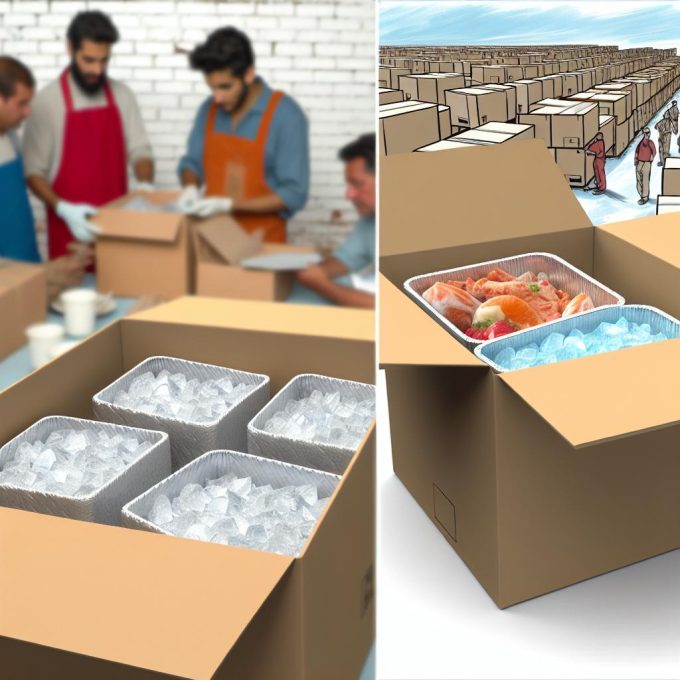Introduction to Insulated Boxes for Shipping Cold Items
Insulated boxes are indispensable tools for businesses that prioritize the temperature-controlled transportation of their products. Key to preserving the quality and safety of items ranging from pharmaceuticals to perishable foods, these boxes are instrumental in ensuring that goods arrive at their destination with their effectiveness intact. The following expansion delves deeper into the materials, design, benefits, applications, and considerations involved in using insulated boxes.
Materials and Design
The performance of insulated shipping boxes is inherently linked to the materials and design used in their construction. These are crafted to provide optimal thermal insulation while also being user-friendly in terms of handling and transportation.
Expanded Polystyrene (EPS)
Expanded Polystyrene, commonly referred to as EPS, remains a prevalent selection in the design of shipping boxes due to its lightweight nature and cost efficiency. Its versatile characteristics allow for configurations in various shapes and sizes, tailored to meet unique shipping needs. EPS’s ability to offer decent insulation at an affordable price makes it a popular option among businesses looking to balance quality and budget.
Polyurethane
Polyurethane stands out for its superior insulation capabilities relative to EPS, making it especially suited for shipments that necessitate prolonged temperature retention. However, the enhanced insulation comes with trade-offs such as increased cost and weight, which might make it less ideal for budget-conscious or weight-restricted applications. Its use is particularly valued when product integrity is non-negotiable over long transport durations.
Vacuum-Insulated Panels
When the utmost in thermal insulation is required, vacuum-insulated panels (VIPs) represent the pinnacle of insulation technology. VIPs offer exceptional insulation due to their sophisticated engineering, though they are typically more expensive. Their deployment is often justified in critical applications where other types of insulation might lag, delivering consistent performance under extreme conditions.
Benefits of Using Insulated Boxes
Insulated shipping boxes offer a host of advantages that underline their importance in the safe transport of temperature-sensitive commodities.
Temperature Control
A fundamental benefit of insulated boxes is their capability to maintain a specified temperature range throughout the shipping process. Sensitive items not only require protection from the external environment but often necessitate stringent internal controls to assure their functional integrity upon arrival.
Preservation of Quality
By minimizing the risk of temperature swings, insulated boxes ensure the long-term preservation of perishable goods. This invaluable benefit decreases the likelihood of spoilage and waste, safeguarding the investment in quality raw materials and preserving brand reputation.
Cost Efficiency
While initial outlays for insulated shipping solutions may appear steep, the potential long-term cost savings are substantial. Reduced product losses, fewer claims for spoilage, and lower reliance on costly expedited shipping confer the benefit of significant financial prudence over time.
Application Across Industries
The use of insulated shipping boxes spans various industrial domains, all united by the fundamental need to uphold temperature consistency.
Pharmaceuticals
Within the pharmaceutical sector, insulated boxes serve a critical purpose: maintaining the stability and efficacy of temperature-sensitive medications and vaccines. For these products, even minor deviations from prescribed temperature ranges can severely impact therapeutic effectiveness, thus reliable shipping solutions are an absolute necessity.
Food Industry
The food sector is another major beneficiary of insulated shipping boxes, employing them in the transportation of diverse product lines from fresh produce to frozen goods. By sustaining appropriate temperature levels, these boxes enable longer storage durations and decline the rate of spoilage, thereby supporting global distribution chains.
Floral and Agricultural Products
Floral and agricultural commodities, which require meticulous temperature control to retain their quality, are prime candidates for insulated shipping. During transit, ensuring freshness and vibrant conditions is essential, helping increase market appeal and customer satisfaction.
Choosing the Right Insulated Shipping Box
The procurement of an insulated shipping box involves considering key factors such as the shipment duration, the necessary temperature control range, the overall weight of the consignment, and the budgetary limitations. Recognizing these elements help companies align shipping solution characteristics with product demands, ultimately ensuring transport integrity.
Learn more about choosing insulated boxes for a detailed guide on matching boxes with transport needs, considering material composition and performance features.
Conclusion
Insulated shipping boxes are crucial in the transportation of temperature-sensitive goods, offering precise temperature control and preserving product quality. With continuous advancements in materials and technology, businesses can expect ever more efficient shipping solutions to emerge, thereby augmenting supply chain efficacy. This adaptability and evolution underscore the continuing significance of insulated boxes in various industries, ensuring products remain secure and effective amidst the complex landscape of global logistics.

